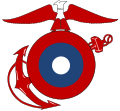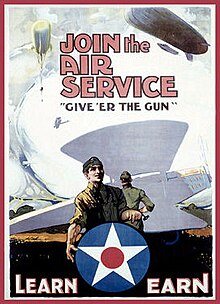United States military aircraft national insignia
This is a listing of the nationality markings used by military aircraft of the United States, including those of the U.S. Air Force, U.S. Navy, U.S. Marine Corps, U.S. Coast Guard, U.S. Army and their predecessors.
The Civil Air Patrol is also included for the World War II period because it engaged in combat operations (primarily anti-submarine flights) which its July 1946 charter has since explicitly forbidden.
From at least as early as the timeframe of the deployment of the First Marine Aviation Force in France during July 1918[4] until roughly 1922, the USMC's aviation units added an American eagle atop the roundel and a fouled anchor superimposed behind the roundel, mimicking the Eagle, Globe, and Anchor emblem on the fuselage sides in the manner of a unit insignia.
In May 1917 the US adopted a red circle-centered white star in a dark blue circular field for all United States military aircraft.
[5] In the months after Pearl Harbor - following the late-June 1941 conversion of the USAAC into the United States Army Air Forces - it was thought that the central red dot could be mistaken for a Japanese Hinomaru, from a distance and in May 1942 it was eliminated.
This still wasn't entirely satisfactory and at least one operational unit refused to add the red, resulting in bare white bars on the existing star roundel.
In the Pacific Theater, some British Commonwealth aircraft in service with the British Pacific Fleet, and Royal New Zealand Air Force, as with Lend Lease Chance Vought F4U Corsairs, began to officially sport the white "bars" as a more-or-less "universal" symbol on Allied aircraft opposing the Japanese, while also eliminating the red center of the roundels they used for the same reason the United States already had.





